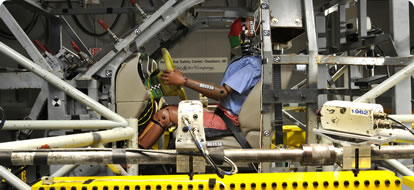Other Technologies/Research
Engineers across the Ford Motor Company brands are continually researching and developing technologies to help drivers avoid accidents and help protect occupants during a collision.
An important element of Ford's research into human behavior is our driving simulator called VIRTTEX, short for VIRtual Test Track EXperiment. VIRTTEX is one of the most advanced laboratories of its kind in the world. Since 2000, Ford has used this controlled laboratory setting to study everyday driving tasks and how they affect driver performance during a variety of simulated driving experiences. Ford has conducted studies in VIRTTEX to investigate driver distraction, drowsy drivers and driver interaction with advanced safety systems. Ford is currently conducting VIRTTEX studies as part of NHTSA's SAVE-IT research project, to investigate ways to reduce distraction-related crashes and improve the effectiveness of safety warning systems.
In the fall of 2005, Ford commissioned the Servo-Hydraulic Reverse Crash Simulator, known as the Servo sled. This state-of-the-art system is reducing the time and cost required for Ford to research, design and build a new car or truck. Located inside Ford's Safety Innovation Lab in Dearborn, the Servo sled is the most capable crash simulator of its type in the world.

Servo-Hydraulic Reverse Crash Simulator, known as the Servo sled
The Servo sled builds on the basic principle of the Hyge sled, a crash test simulator Ford has used for more than 40 years. The Hyge and Servo sleds each sit inside a corridor about the width of a two-lane highway and about 50 yards long. A track runs the length of the corridor with the sled on top of it. On top of the sled sits a "buck" – an accurate representation of the interior of the vehicle to be tested (including seats, instrument panel, windshield, airbags, seat belts, etc.). Crash test dummies are positioned in the buck.
To launch a test, the buck and sled are propelled to more than 35mph in a few milliseconds. The sled and buck can be used again, but the seats, seat belts, airbags and so forth must be replaced before another test can be performed.
The Servo sled is a significant improvement over the Hyge, for several reasons. Most important, it more accurately represents a vehicle's "pulse," or the acceleration experienced in the occupant compartment during a full vehicle crash test. This reduces the number of full crash tests that must be conducted. The Servo sled can also simulate vehicle pitching and side-impact events, which the Hyge cannot. In short, the new Servo sled allows more representative testing in a given time period, at a lower cost than previously, and enables Ford to more quickly bring safety features to market.